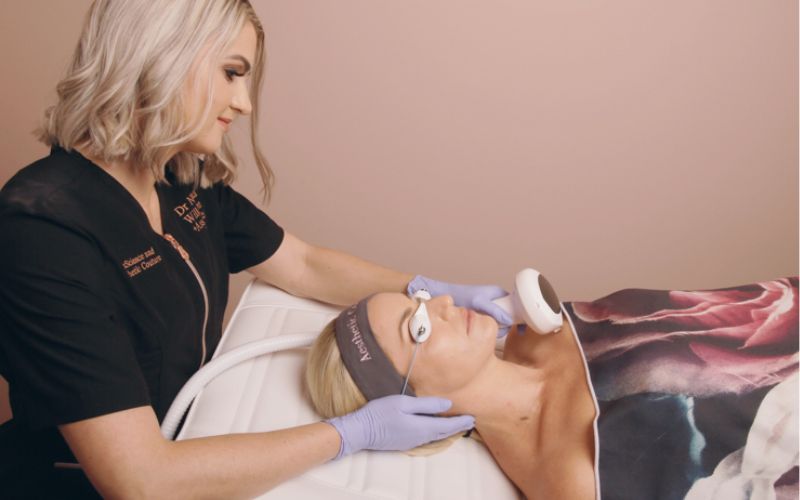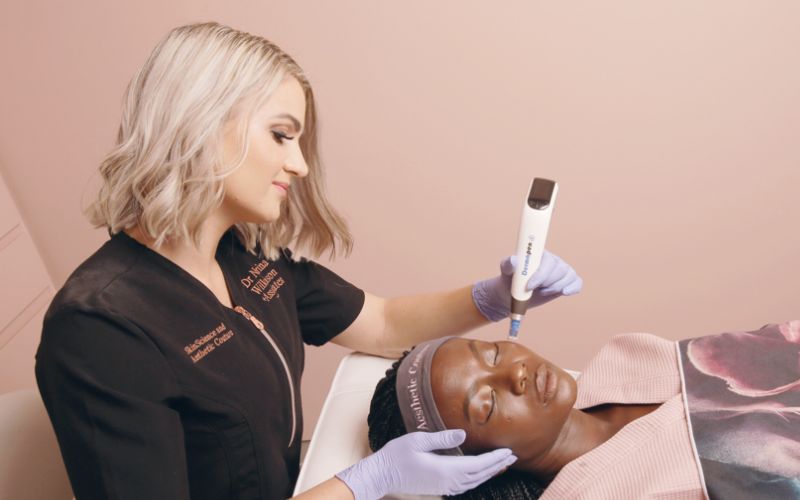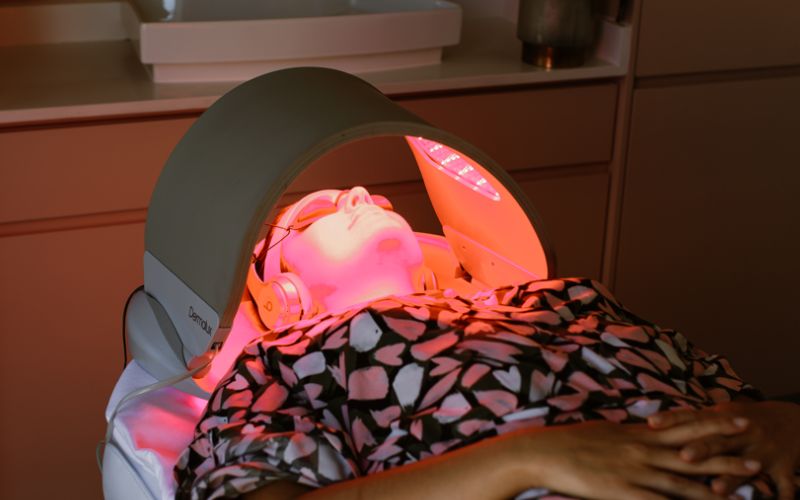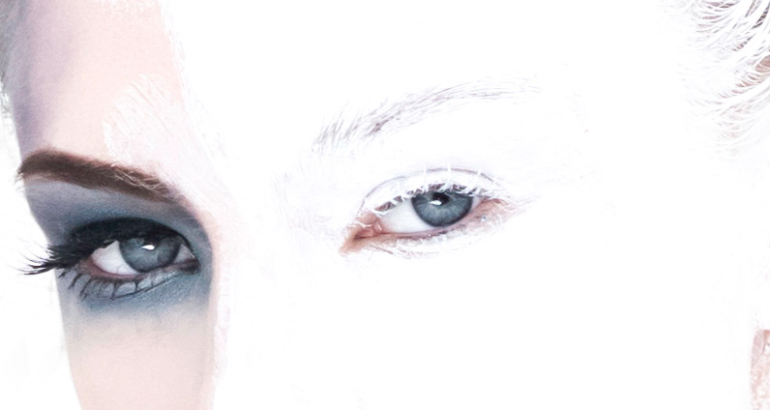by Skincare Specialist, Louné Maree
Rosacea is a chronic skin condition that affects 5.5% of the world’s adult population. In this article we will cover all basis of Rosacea; the types of Rosacea, the causes and triggers, treatments that can help manage this condition, and tips on what you can do to help keep it at bay.
This can be a very sensitive topic for some people, but to help put your mind at ease, it helps to know that many celebrities also suffer from Rosacea. Renee Zellweger, Sofia Vergara, and Prince William just to name a few. The key to managing Rosacea is understanding the condition and how we can treat it internally and externally.
Table of contents
- UNDERSTANDING ROSACEA
- WHAT IS ROSACEA?
- HOW DOES VASCULARITY DIFFER FROM ROSACEA?
- THE DIFFERENT TYPES OF ROSACEA
- WHAT CAUSES ROSACEA?
- WHAT TRIGGERS ROSACEA FLARE-UPS?
- TREATMENT OPTIONS FOR ROSACEA MANAGEMENT
- FINAL THOUGHTS ON MANAGING ROSACEA
UNDERSTANDING ROSACEA
Rosacea is a medical condition that affects the facial skin. There is no specific test that can be done to diagnose Rosacea, but your skin specialist will examine your skin and ask you questions about your medical history to help make a relevant diagnosis. In doing so we also rule out conditions that can be disguised as Rosacea such as allergies or lupus.
WHAT IS ROSACEA?
Rosacea is a chronic inflammatory skin disorder that primarily affects middle-aged women with fair skin. It is characterised by redness, small pimple-like bumps and usually affect the nose and cheeks.
HOW DOES VASCULARITY DIFFER FROM ROSACEA?
Our skin contains a vascular system that is made up of blood vessels that carries blood and lymph throughout the body. This includes capillaries, the smallest blood vessels that connect our arteries and veins. With a Rosacea patient, you will find these tiny capillaries to be broken which in turn causes the skin to be constantly red.
Broken capillaries and Rosacea are very similar, however, they each have entirely different causes, as broken capillaries alone are often affected by lifestyle choices, whereas Rosacea is a chronic inflammatory skin condition.
THE DIFFERENT TYPES OF ROSACEA
Rosacea is divided into 4 types each with their own distinct characteristics, let’s go through them…
Erythematotelangiectatic Rosacea
Erythematotelangiectatic (ETR) Rosacea is characterized by flushing and persistent central facial redness and visible blood vessels. The name comes from the word ‘erythema’, which refers to the reddening of the skin surface, and ‘telangiectasia’ which is the condition of dilated blood vessels just below the skin surface. With ETR you can experience dryness, warmth, and tingling.
Papulopustular Rosacea
Papulopustular Rosacea is characterized by persistent redness with pus-filled bumps. One should not confuse Papulopustular Rosacea with acne vulgaris, the two are different conditions that should be identified as such, as the treatment approaches will also be different. The name comes from papules (tiny, raised bumps) and pustules (bumps containing yellow pus) commonly found on the cheeks, chin, and forehead.
Ocular Rosacea
Ocular Rosacea is characterized by red, burning, and watering eyes. A person can suffer from rosacea without the eye area being affected and the other way around, by having both forms of rosacea. Ocular Rosacea is the feeling of something is stuck in your eye accompanied by swelling and irritation.
Phymatous Rosacea
Phymatous Rosacea is characterized by thickened irregular skin tissue causing swelling, bumps, and in some cases discoloration and disfiguration. Another name for this condition is Rhinophyma referring to the nose that is being affected.
WHAT CAUSES ROSACEA?
The exact cause of Rosacea is unknown, but it could be due to an overactive immune system, heredity factors, environmental factors, or a combination of these.
WHAT TRIGGERS ROSACEA FLARE-UPS?
There are several factors called triggers that can cause Rosacea to flare up, by avoiding these everyday common triggers you will be able to manage and control the Rosacea effectively. Let’s run through them…
Sun exposure and its impact on Rosacea
Heat and sun exposure are two of the most common Rosacea triggers. What happens during sun exposure is the upregulation of vascular endothelial growth factors, which is a substance that stimulates new blood vessels – something we do not want in Rosacea-prone skin. Protecting the skin from the sun’s harmful rays with sunscreen is of the utmost importance. Applying a sun protection factor in the morning and mid-day will help to prevent a flare-up.
The impact of extreme weather conditions on Rosacea
Warm temperatures can cause an increase in blood flow which leads to facial flushing and aggravate your Rosacea symptoms, during the summer months protect your face with sunscreen, wear a hat, and stay cool using a spray bottle filled with cold water. The same goes for cold temperatures where Rosacea will flare up due to windburn, therefor protect your face from wind and cold and wear a scarf.
Spicy foods as a Rosacea trigger
Spices and spicy food are most frequently reported as a trigger implicated in Rosacea, with up to 75% of people suffering from this condition spicy food has worsened their symptoms. Spicy food causes blood vessels to dilate and increase blood flow which can turn the skin bright red, itching, and hot. To avoid the situation, one should make changes to their diet including prebiotic foods like legumes, oatmeal, fatty fish like salmon, walnuts, and bananas.
The impact of alcohol on Rosacea
Alcoholic beverages particularly red wine and hard liquor stimulate the production of inflammatory cytokines, causing the skin to swell, at the same time vasodilating takes place contributing to facial redness and flushing. Ideally, cut out alcohol or limit the consumption thereof to help keep Rosacea flare-ups at bay.
Emotional stress can trigger or worsen Rosacea
Life can be stressful, but some people live with chronic stress and anxiety which manifests as an emotion that has proven to trigger Rosacea flare-ups. Incorporating stress management techniques such as breathing exercises, physical activities, and 7-8 hours of sleep can be beneficial to managing the symptoms of Rosacea.
Intense physical activity as a Rosacea trigger
Exercise is an important part of a healthy lifestyle, unfortunately for those who suffer from Rosacea strenuous exercise will cause a flare-up due to increased blood circulation which leads to flushing. To prevent this from happening consider lower-impact activities like yoga, walking, and swimming preferably indoors as heat is a major aggravator when it comes to Rosacea.
Skincare products that aggravate Rosacea
Certain skincare products can aggravate Rosacea-prone skin such as bar soap, throwing the skin microbiome (barrier) out of balance and causing dryness and irritation. Rather stick with a soap-free, non-fragrance gentle cleanser. Glycolic and lactic acid are both excellent exfoliators causing a tingling sensation on the skin which already tells you it’s too stimulating for an already red skin.
An alternative to removing dead skin cells is using polyhydroxy acid which provides additional moisturizing properties. Chemical sunscreen infiltrates the skin converting UV rays into heat, which is the last thing we want on Rosacea-prone skin, rather opt for a physical sunscreen that sits on top of the skin reflecting UV rays.
TREATMENT OPTIONS FOR ROSACEA MANAGEMENT
While there is no cure for Rosacea, it can be effectively managed with a targeted professional skincare treatment approach. Treatment options include professional interventions such as intense pulsed light treatment, chemical peels, medical skin needling, and more. Let’s take a closer look at some of our favourites!
Intense Pulsed Light Treatments for Rosacea
Intense pulsed light (IPL) such as Lumecca IPL is a safe and effective treatment for the appearance of redness in Rosacea skin. IPL uses light energy that converts into thermal energy to coagulate blood vessels to reduce the appearance of redness.
IPL is a versatile treatment, by using different wavelengths, durations, and fluences we are able to treat vascular lesions and pigmented lesions such as Rosacea, broken capillaries, sun damage, freckles, and more.
Chemical Peel Treatments for Rosacea
Chemical peels, such as the Azelan Peel, enhance skin texture and alleviate Rosacea symptoms. By removing damaged outer layers, these peels reveal healthier and smoother skin. The Azelan Chemical Peel is a popular choice for Rosacea treatment due to its effectiveness in improving the overall skin condition and texture in a very gentle, yet effective way.
Microneedling Treatments for Rosacea
Medical skin needling, also known as micro-needling, can improve Rosacea symptoms by stimulating collagen production and reducing redness. The controlled micro-injuries created during the procedure promote skin rejuvenation and help minimise the appearance of blood vessels associated with Rosacea.
Medical skin needling is a minimally invasive treatment that can be combined with topical medications and medical actives (as we do with our signature 3D Needling treatment) to further enhance its effectiveness.
LED Light Therapy for Rosacea management
Dermalux LED Light Therapy uses a combination of pure visible red, blue, and infrared light to stimulate the deeper skin tissue. It can be used as a stand-alone treatment or combined with various other treatments to optimise results and assist in healing.
Red LED light increases natural hydration levels, reduces redness and inflammation, shrinks the appearance of pores, regulates oil production, improves circulation, and is medically approved to treat Rosacea.
Signature Skincare for Rosacea
At Dr Nerina Wilkinson + Associates we offer a unique 3D Bespoke Treatment experience, formulated to address Rosacea and other individual skincare concerns. The treatment combines modalities such as a chemical peel, medical skin needling or mesotherapy, and a specialized mask to target and help reduce the signs of Rosacea. Clinically proven to calm inflammation and stimulate cell regeneration, this combined treatment helps alleviate redness, improve skin texture and tone, and reduce the appearance of rosacea-related symptoms.
With our ability to customise the treatment to individual needs, the combined approach effectively addresses rosacea, promoting a healthier, calmer, and more even complexion.






